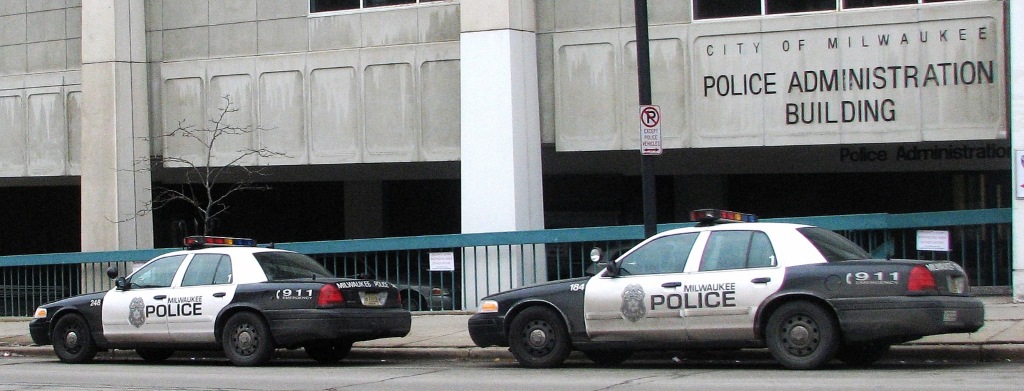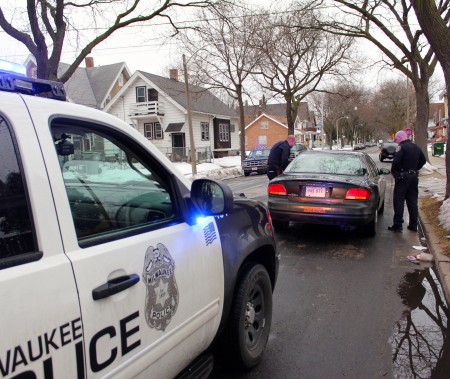Can Violence Reduction Program Work?
Milwaukee one of 10 cities chosen for federal program, but may not address root causes, critics say.

Milwaukee Police Department squad cars parked in front of the department’s administration building. Photo by Brendan O’Brien.
Milwaukee’s selection to participate in a network of cities across the United States that work together and with federal law enforcement agencies to fight crime has prompted renewed calls to address the root causes of violence in the city.
Milwaukee was named to the Department of Justice’s nationwide Violence Reduction Network on the heels of recording the most annual homicides in a decade. The city must begin to address the rampant poverty and gripping segregation that ultimately leads to crime, according to Alderman Ashanti Hamilton.
“Unless and until we are really ready to have that honest conversation about those root causes, we will remain on the list for requesting the enforcement resources that are necessary to combat these problems,” Hamilton said. “The reason our city is unsafe is because we have concentrated poverty in certain parts of the city, which is going to produce a certain level of violence.”
One of the root causes of violent crime in Milwaukee is the fact that one in every three residents lives in poverty and, in some parts of the city, half of residents are impoverished, Hamilton said.
Milwaukee, along with New Orleans and St. Louis, recently joined 10 other cities participating in the Violence Reduction Network. The network will give the city access to training and technical assistance from crime-fighting experts, and techniques that have been effective in other cities.
“From my perspective, we are always in favor of more resources being dedicated to violence reduction,” said Katie Sanders, Safe & Sound executive director. “A coordinated law enforcement effort is going to be very helpful, but law enforcement is not the only solution that is required.”
To address violent crime in Milwaukee, more community-based solutions are needed to create collective neighborhood efficacy and to reduce the concentrated disadvantage that exists in the city, she said.
“We are not doing enough and as a community we can do much more,” Sanders said.
The city has been proficient at capturing millions of federal dollars for these types of efforts through a Building Neighborhood Capacity Program grant, a Byrne grant and a Choice Neighborhoods Initiative Implementation Grant.
“We still haven’t been able to …change our policy perspective to embrace what those grants are supposed to teach us,” Hamilton said. “I don’t want to get too excited about (the network), if we are not going to embrace learning from the folks that are coming in.”
Milwaukee will be assigned a liaison who will help navigate federal resources and help implement new local violence reduction initiatives. The city also will be invited to an annual network summit.
“The Milwaukee Police Department looks forward to working with our law enforcement partners both federal and local, in utilizing evidence-based crime fighting strategies to combat violence in Milwaukee,” said Timothy Gauerke, a department spokesman.
Wilmington, Delaware, a city about one-eighth the size of Milwaukee, has been a part of the network since August 2014. Overall crime there has decreased 12 percent and shots fired have decreased by a third since 2013, according to federal data. The city’s police department also created a homicide unit that has increased the homicide clearance rate from less than 10 percent to more than 50 percent for current-year cases, according to the justice department.
In Chicago, the network has helped police post videos showing sexual assault suspects on Facebook, leading to more arrests. In Detroit, police learned to use data analysis techniques through the network to identify warning signals to prevent domestic violence homicides.
It is too early to tell exactly what form the network will take in Milwaukee, according to federal law enforcement officials.
State Sen. Lena Taylor said that while collaborative work and learning about practices that have worked in other parts of the country will be a positive for Milwaukee, the city must address its own ills, particularly in relation to youth.
“If we are not giving people options, if we are not restoring hope, and we are not restoring trust, then we’re not where we need to be,” she said about youths’ interactions with Milwaukee police. “With young people, it’s all about trust.”
This story was originally published by Milwaukee Neighborhood News Service, where you can find other stories reporting on fifteen city neighborhoods in Milwaukee.


















